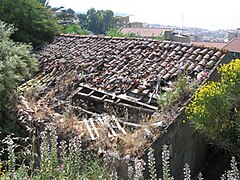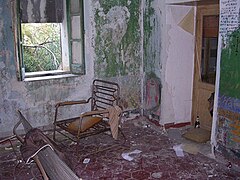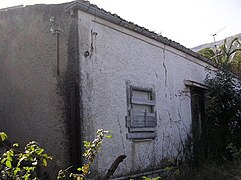Abbey of Thelema
 Abbey of Thelema, 2017 | |
| Monastery information | |
|---|---|
| Full name | The Abbey of Thelema in Cefalù |
| Order | A∴A∴ |
| Established | 1920 |
| Disestablished | 1923 |
| Dedicated to | Nuit |
| Controlled churches | Gnostic Catholic Church |
| People | |
| Founder(s) | Aleister Crowley |
| Site | |
| Location | Cefalù, Italy |
| Visible remains | chapter house, sacristy, parts of the frater and infirmary room |
| Public access | free access |
| Part of a series on |
| Thelema |
|---|
 |
| The Rights of Man |
The Abbey of Thelema is a small house which was used as a temple and spiritual centre, founded by Aleister Crowley and Leah Hirsig in Cefalù (Sicily, Italy) in 1920.[1]
The villa still stands today, but in poor condition. Filmmaker Kenneth Anger, himself a devotee of Crowley, later uncovered and filmed some of its murals in his film Thelema Abbey (1955), now considered a lost film.[2]
Name
[edit]The name was borrowed from François Rabelais's satire Gargantua and Pantagruel,[3] where an Abbaye de Thélème is described as a sort of "anti-monastery" where the lives of the inhabitants were "spent not in laws, statutes, or rules, but according to their own free will and pleasure."[4] Prior to arriving at the name, Crowley referred to the house as Villa Santa Barbara.[5] The name "Thelema" is derived from the Greek θέλημα (« thélêma »), which refers to 'divine will'.
Objectives
[edit]This idealistic utopia was to be the model of Crowley's commune, while also being a type of magical school, giving it the designation "Collegium ad Spiritum Sanctum", A College towards the Holy Spirit. The general program was in line with the A∴A∴ course of training, and included daily adorations to the sun, a study of Crowley's writings, regular yogic and ritual practices (which were to be recorded), as well as general domestic labor. The object was for students to devote themselves to the Great Work of discovering and manifesting their True Will.[citation needed]
Crowley had planned to transform the small house into a global center of magical devotion and perhaps to gain tuition fees paid by acolytes seeking training in the Magical Arts; these fees would further assist him in his efforts to promulgate Thelema and publish his manuscripts.[citation needed]
Residents
[edit]
Raoul Loveday
[edit]In 1923, a 23-year-old Oxford undergraduate, Raoul Loveday (or Frederick Charles Loveday), died at the Abbey. His wife, Betty May, variously blamed the death on his participation in one of Crowley's rituals (allegedly incorporating the consumption of the blood of a sacrificed cat) or the more probable diagnosis of acute enteric fever contracted by drinking from a mountain spring. Crowley had warned the couple against drinking the water, as reported in biographies by Lawrence Sutin, Richard Kaczynski and others.[citation needed]
When May returned to London, she gave an interview to a tabloid paper, The Sunday Express, which included her story in its ongoing attacks on Crowley. With these and similar rumors about activities at the Abbey in mind, Benito Mussolini's government demanded that Crowley leave the country in 1923. After Crowley's departure, the Abbey of Thelema was eventually abandoned and local residents whitewashed over Crowley's murals.[citation needed]

Jane Wolfe
[edit]Jane Wolfe worked with Crowley's Thelemic system of training in Cefalù for three years, and emerged from those years with a degree of attainment, having survived Crowley’s ordeals. Whilst a resident at the Abbey of Thelema, Wolfe was admitted to the A∴A∴ by Crowley, taking the magickal name Soror Estai. She undertook various practises including yoga, dhāraṇā and pranayama of which she kept a detailed record which was later published by the College of Thelema of Northern California as The Cefalu Diaries.[6] She later worked as Crowley’s personal representative in London and Paris.[7]
In popular culture
[edit]Danish artist Joachim Koester created five colour and five black and white photographs of the villa; these photographs comprise his Morning of the Magicians (2005) work.[8]
Gallery
[edit]-
Ruins of the Abbey
-
Abbey of Thelema, current rooms
-
Abbey of Thelema, the present chapel
See also
[edit]References
[edit]Citations
[edit]- ^ Sutin (2002), p. 279.
- ^ MacDonald (2006), p. 49.
- ^ Wilson, Colin (2005). Aleister Crowley: The Nature of the Beast. Aeon Books. p. 73.
- ^ Rabelais, François (1534). La vie très horrifique du grand Gargantua, père de Pantagruel [The Very Horrific Life of Great Gargantua, Father of Pantagruel]. France. pp. Chapter LVII.
- ^ Kracht & Woodard (2011), p. 185.
- ^ Shoemaker (2017a).
- ^ Seckler (1979), p. 35.
- ^ "Joachim Koester - MoMA". The Museum of Modern Art.
Works cited
[edit]- Kracht, Christian; Woodard, David (2011). Five Years. Hanover: Wehrhahn Verlag. ISBN 978-3-86525-235-7.
- MacDonald, Scott (2006). A Critical Cinema 5: Interviews with Independent Filmmakers. University of California Press. ISBN 0520245946.
- Seckler, Phyllis, ed. (1979). "[missing title]". In the Continuum. II (5). Oroville, CA: College of Thelema Publishing.
- Shoemaker, David, ed. (2017a). Jane Wolfe: The Cefalu Diaries 1920 - 1923. Temple of the Silver Star. ISBN 978-09976686-3-6.
- Sutin, Lawrence (2002). Do What Thou Wilt: A Life of Aleister Crowley. Macmillan. ISBN 978-0312252434.
Further reading
[edit]- Seckler, Phyllis (2010). Rorac Johnson; Gregory Peters; David Shoemaker (eds.). The Thoth Tarot, Astrology & Other Selected Writings. Teitan Press & College of Thelema of Northern California. ISBN 978-0-933429-27-7.
- Seckler, Phyllis (2012). Rorac Johnson; Gregory Peters; David Shoemaker (eds.). The Kabbalah, Magick, and Thelema. Selected Writings Volume II. Teitan Press & College of Thelema of Northern California. ISBN 978-0-933429-28-4.
- Shoemaker, David (2017b). Karl Germer: Selected letters. Temple of the Silver Star. ISBN 978-0-997668-65-0.
- Starr, Martin P. (2003). The Unknown God: W.T. Smith and the Thelemites. Bollingbrook, Illinois: Teitan Press. ISBN 978-0-933429-07-9.
External links
[edit]- 20th-century religious buildings and structures in Italy
- 1920 establishments in Italy
- 1923 disestablishments in Italy
- 20th century in Sicily
- Aleister Crowley
- Buildings and structures in the Metropolitan City of Palermo
- Religious organizations disestablished in 1923
- Religious organizations established in 1920
- Secret societies in Italy
- Thelema
- Villas in Sicily



